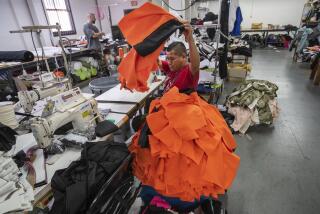Military Demand Propels 2.2% Rise in Factory Orders
- Share via
WASHINGTON — U.S. factory orders, propelled by a 44.7% increase in demand for military equipment, climbed 2.2% in July for their best gain since late 1984, the government reported Tuesday.
Economists, however, took little encouragement from the report, contending that the strength in defense did little to raise hopes for revival in the weak manufacturing sector.
Meanwhile, the government also reported that construction spending climbed 0.5% in July, the largest increase since April, as strength in single-family homes and government projects offset declines in office buildings and apartment units.
The Commerce Department said orders for manufactured goods totaled $196.01 billion in July following declines in May and June. The increase matched a gain last December and was the strongest advance since a 4.4% rise in November, 1984.
Analysts Generally Unimpressed
However, orders would have risen only 0.5%, the same as in June, without a big surge in the ordering of defense equipment.
For this reason, analysts were generally unimpressed.
“The 2.2% gain looks encouraging on the surface, but it is almost all defense,” said David Wyss, economist for Data Resources in Lexington, Mass. “The fact that the rise was so narrow does cast doubt on how much it is going to help the economy.”
David Berson, economist for Wharton Econometrics in Philadelphia, said the civilian portion will need to show stronger increases before economists can be hopeful that overall manufacturing is reviving. American factories have been battered for the past two years by a flood of imports.
“Even if we begin to see some improvements in manufacturing, it is so far in the doldrums that it will take a number of months to get us back to a level where we should be,” Berson said.
Wyss predicted that economic growth will show little improvement in the second half of the year. He said chances of a recession sometime next year were growing because of expected adverse impacts from the new tax overhaul awaiting final congressional approval.
“The only thing that will keep us out of a recession early next year will be the tremendous push by the Federal Reserve to keep shoving interest rates lower,” Wyss said.
The rise in factory orders included a 4.1% increase in orders for durable goods, items expected to last three or more years. This was a slight revision from a 4.3% increase estimated in an advance report 11 days ago.
Orders for non-durable goods were flat in July following a 0.5% decline in June.
Sharp Upturn in Month
The 44.7% jump in orders for defense goods followed a 14% decline in June, with much of the strength coming from heavy military demand for aircraft.
The category of non-defense capital goods rose 3.6% in July as civilian companies also increased their purchases of planes. Analysts said much of this increase came from a big aircraft order placed with Boeing Co.
Orders for transportation equipment rose 21.9%, with demand for aircraft accounting for more than 80% of this increase.
The largest decline in the durable goods sector was in electrical machinery, which dropped 5.3% following a 22.3% increase in June. Orders for primary metals such as steel declined by 2.7%.
Shipments of manufactured goods rose 0.4% in July to $194.4 billion following a 0.3% June advance. Before that, shipments had steadily declined--to $193.1 billion in May from a high of $200.1 billion last November.
The construction report said the government and private companies were building at an annual rate of $376.7 billion in July.
Analysts said that falling mortgage rates will ensure that single-family home construction does well for the rest of the year but that the adverse impact from the new tax law and overbuilding will further dampen activity in the apartment and office building sectors.
More to Read
Inside the business of entertainment
The Wide Shot brings you news, analysis and insights on everything from streaming wars to production — and what it all means for the future.
You may occasionally receive promotional content from the Los Angeles Times.










